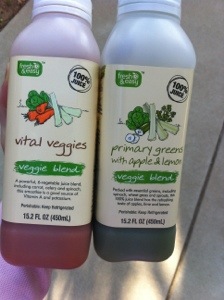
Bottled vegetable juice
I discovered that the grocery store in town sells fresh veggie juices. Score! If you’re eating in a way to reduce anxiety you want to stay away from fruit juices which contain a ton of sugar. (It’s better to eat those same fruits so that their fiber slows down the digestion of their sugar.) And you already know the benefits of vegetables. Enter veggie juice, stage left.
If you just let an audible “yuck” slip past your lips, I’m guessing your only exposure to veggie juice has been the V-8 crap taking up room on the grocery shelves. That was me a couple years ago. In reality, fresh vegetable juice tastes amazing when it’s done well, whether you make it yourself or buy it bottled.
My partner and I do own a juicer which we don’t use frequently, but often enough to justify keeping it around. It’s easy to use but a pain in the neck to clean, and you do need to clean it thoroughly after every use. I would use it a lot more if it weren’t for that reason.
So, for people like me bottled juices are the way to go! Bust out the juicer when you want a custom drink.
Look for a veggie juice that has a lot of variety and minimal fruit involved (make sure there are less than, say, 12-15 grams of sugar). If you’re just dipping your toes in to the veggie juice pond, you could cut it with a bit of citrus or a splash of apple juice to cut the “green” flavor.
Here are some of my tips about juice and juicing:
- Drink it ASAP, preferably right away, then preferably within the first day.
- Best veggies for juicing: beets, carrots, bell peppers, greens (especially spinach & kale), celery & cucumber (these add water), ginger, parsnips.
- If your sweetheart doesn’t like beets, trick them by using the orange ones! (wink, wink)
- Some veggies are terrible in juice, like broccoli and brussels sprouts. Eat them cooked instead.
- If you go the bottled route, rinse and save your plastic bottles so you can eventually get your recycling deposit back.
